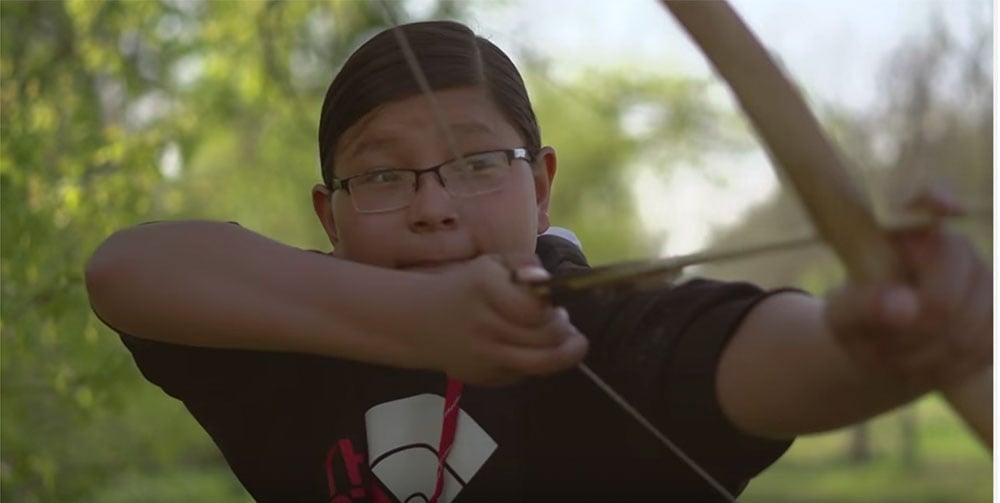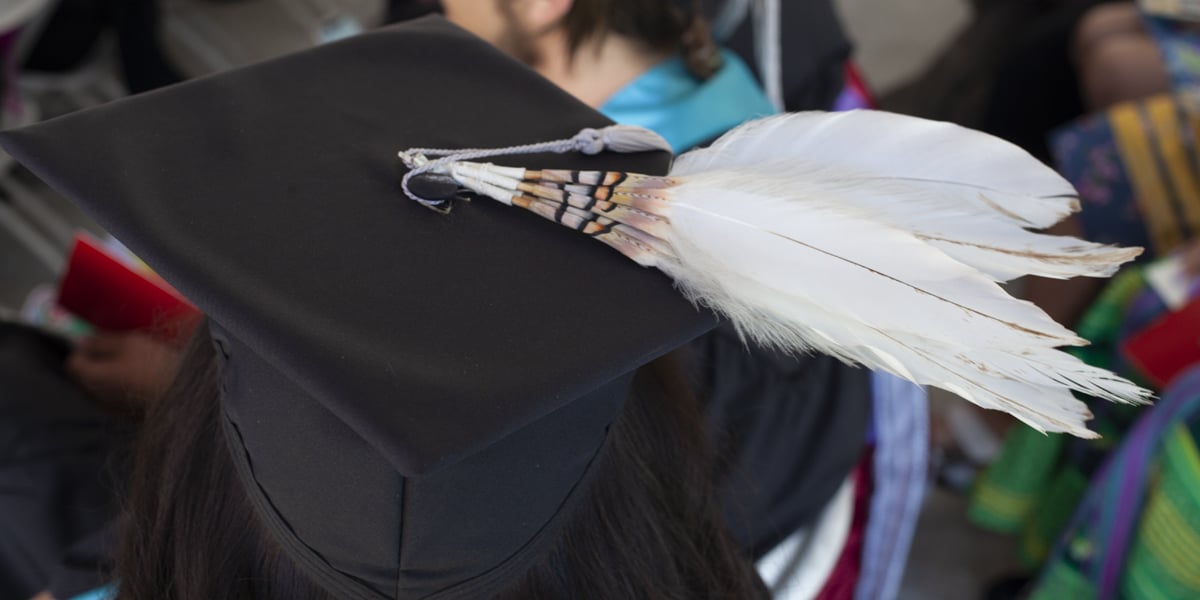May 20, 2024 | Native Hope
Fashion is a language, a signal that tells others who you are and what you represent. However, the fashion industry has for centuries exploited class, race, gender, and the products used in its creation. In a perhaps surprising turn of events, the emerging Native Fashion Industry is turning the tables on exploitation to become a beacon of representation, reclamation, resilience, and empowerment for a new generation of fashionistas.
Students at St. Joseph’s Indian School recently workshopped and put on a fashion show with professionals in the Native fashion Industry, gaining valuable insights into Native fashion trends and the profound life lessons to be found in the contemporary Native fashion world. The event is the brainchild of houseparent Kirstie Mattos, Mrs. USA Ambassador South Dakota, who has first-hand involvement in the fashion industry and knows the positive benefits it can bring the students.
To fully understand the complex of issues that swirl around the use and misuse of Indigenous fashion is to witness the trauma caused by generations of injustice, cultural appropriation, and marginalization endured by Native Americans. At the same time, it is to explore the healing power of fashion and to comprehend the genius of the Native fashion industry and its value for strengthening the cultural identity of Native youth.
Perhaps no one in the industry is more iconic than Kelly Holmes of Native Max magazine. At a mere 20 years of age, Holmes (Mnicoujou Lakota from the Cheyenne River Reservation) parlayed her experience as a model, writer, designer, and stylist into what today is Native Max New Media. Her goal: To promote self-esteem, self-respect, and pride in Native communities. Native Max New Media is an award-winning global multimedia brand with platforms that elevate Indigenous talent across print, digital, web, mobile, video, events, e-commerce, and partnerships. She bolsters these efforts through Native Fashion in the City supporting modern Native American fashion designers and talent, and a venture-capital model that supports early-stage start-ups with Indigenous, Black, Brown, and female talent.
Native fashion today is Indigenous-led, Indigenous-owned, and an expression of Indigenous culture, identity, healing, and more. But, this was not always the case.
Cultural appropriation vs. appreciation
According to Britannica, cultural appropriation is the adoption of certain language, behavior, clothing, or tradition belonging to a minority culture or social group by a dominant culture or group in a way that is exploitative, disrespectful, or stereotypical. From Halloween to Hollywood to stadiums across the country to the classroom, “dressing up” as a Native American has for centuries given an inaccurate perspective of Native culture and identities.
Cultural appropriation of Native fashion in the United States has suggested not only that Native American life and cultures existed only in the past, but also that Native clothing was mere costuming, primitive, warlike, or only for mascots.
Minnesota-based Minnetonka, a purveyor of handcrafted leather footwear, is a good example of brand that has transformed itself from being exploitative to more authentically Native. Their work demonstrates the important shift from cultural appropriation to cultural appreciation that is coming about, in part, due to the emerging Native American fashion industry.
Begun in 1946 on the shores of Lake Minnetonka, the then-fledgling footwear company took its name from that lake and took its inspiration from traditional Native American clothing, including moccasins, beadwork, and design patterns. In 2020, the company took what it rightly called a “long overdue step” of “acknowledging and apologizing for … historic appropriation of Native American culture and design.” They took responsibility by acknowledging Native influence on their products, expanded their support of the Native community, and began collaborating with Native artists Adrienne Benjamin on a line of beaded hats Lucie Skjefte on beaded moccasin designs.
The healing power of Native American Fashion
The Minnetonka experience points to the healing power of Native American fashion today. When cultural identity is reclaimed with pride, many feel the weight of centuries-old trauma lifted. Healing and fashion in Native America have long been synonymous, perhaps best exemplified in the Jingle dress.
The dress and dance come to Native America through three Ojibwa communities. Though versions of its origins vary somewhat, in the Mille Lacs’ story says the tradition was born of a medicine man whose daughter was gravely ill. In a dream, four women wore dresses covered in metal cones and danced a healing dance. He instructed his wife how to make the dresses, and when four women danced at a ceremony, the daughter sat up, began dancing with the women, and was healed. Today, Jingle dress dancers dance for the healing and well-being of others.
Delina White, herself an “old style jingle dress dancer,” created Native Nations Fashion Night, the largest showcase of Indigeous fashion in the Upper Midwest. The event showcases the talent of Indigenous fashion designers, models, hairstylists and makeup artists. Minnesota Lt. Gov. Peggy Flanagan of the White Earth Band of Ojibwe modeled at the fourth-annual runway show in 2024.
During the COVID-19 epidemic, Tami Buffalohead McGill, embraced the healing tradition of Native American fashion when she founded Healing Ribbons. The intergenerational group of Indigenous women promotes healing and strengthens cultural identity by creating culturally significant garments, beadwork, ribbon skirts, and more. Through their work, the women are empowered by their culture, experience healing from historical trauma, and celebrate their identity and resilience.
Increasingly, mental health professionals appreciate how the history of colonialism affected Native Americans and are learning how the embrace of culturally appropriate values, traditions and spirituality promotes healing. At the heart of the matter is the reclamation of cultural pride and identity. Indeed a key protective factor in raising children who make good choices and avoid risky behaviors is pride and connection to culture.
Native American Fashion is More than moccasins
Cultural representation takes center stage in Native American fashion, as expressed by aspiring model Cante Rencountre who participated in the tenth annual Native Fashion in the City in Denver, Colo. The senior at St. Joseph’s Indian School noted, “Native culture is underrepresented,” commenting on the difficulty of growing up without seeing herself in the dominant culture. She treasured the opportunity to represent her culture, herself, and her family. Rencountre can be seen in a Native Max’s Native Heritage edition wearing the “Sing to me Blue Birds” dress from Bitterwater for Redhouse by Michelle Luna with accessories by S.N.O Inc. While beadwork and design bear Native elements, the overall aspect of the fashion is strikingly modern.
Native American designers have a rich palate at their fingertips to draw from traditional Native American clothing that includes Native American quillwork, Native American beadwork, Native doll making, headdresses, and Plains Indian clothing. But more and more, contemporary Indigenous designers are moving away from artifact-based expressions to broader representations. Modern Native American fashion designers both embrace a rich Indigenous heritage and elude classification, sometimes using fashion as a platform for social comment and often defying notions of Native American style.
Through the deeper exploration into the transforming world of Native fashion, students at St. Joseph’s Indian School are learning more about the beauty of their cultural identity and finding pride in the resiliency of their people – a valuable lesson as they chart their way into the future, whether as fashion models or role models on the path of their choosing.



COMMENTS